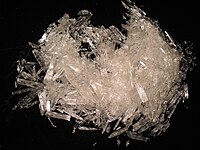
Photo from wikipedia
BACKGROUND Characterisation of mosquito repellents using arm-in-cage tests are performed by assessing the 95% effective dose (ED95), half-life and complete protection time (CPT). This study fully characterizes these properties for… Click to show full abstract
BACKGROUND Characterisation of mosquito repellents using arm-in-cage tests are performed by assessing the 95% effective dose (ED95), half-life and complete protection time (CPT). This study fully characterizes these properties for p-menthane-3,8-diol (PMD), which has not been widely studied, and a long-acting formulation containing a PMD-vanillin composite. METHODS A series of arm-in-cage tests against Aedes aegypti (Diptera: Culicidae) mosquitoes were devised using 6 volunteers to estimate CPT or 10 to estimate the ED95 and half-lives for three repellents: 20% N,N-diethyl-3-methylbenzamide (DEET), 30% PMD and a novel 30% PMD-vanillin formulation. Non-linear regression analysis was used to characterize the relationship between applied dose and CPT. RESULTS PMD and DEET showed a very similar log dose relationship to CPT; however, the PMD-vanillin formulation exhibited a sigmoidal 'S-shaped' relationship. This resulted in a 1.5-fold higher CPT for PMD-vanillin compared with that of 20% DEET when applied at a dose of 1.6 mg/cm2, but little difference was observed at lower doses of 0.8-1 mg/cm2. The ED95 value for the 30% PMD and PMD-vanillin formulations were 0.25 and 0.24 mg/cm2, respectively, these being higher than that for 20% DEET (0.09 mg/cm2). The half-lives for 30% PMD and 20% DEET were similar (2.23 vs. 2.74 h), but longer for the PMD-vanillin formulations (3.8 h). CONCLUSIONS A full characterisation for other repellent formulations, particularly those claiming extended longevity, should be conducted in order to identify differences at various applied doses.
Journal Title: Transactions of the Royal Society of Tropical Medicine and Hygiene
Year Published: 2020
Link to full text (if available)
Share on Social Media: Sign Up to like & get
recommendations!